
| [ Nihon kiin TOP ] |
HOW TO PLAY GO [1/3]IntroductionThe game of'Go'has its origin in China 4,000 years ago. It is more than 1,300 years since'Go'was introduced to Japan. During these centuries, the ancient Chinese form of'Go'has been modified and improved by the Japanese.'Go'as it is played today is an indoor game which has no further room for improvement. It has taken roots deep in the life of the people of Japan. The total number of people who play'Go'is estimated to be about seven million.
There are many'Go'players outside Japan-a fact which should be a source of joy for us. Now, what kind of game is'Go?' A Game for Winning Territory'Go'is a game in which two players contest for territory. One of the two players uses black stones and the other white stones to mark out their respective territories. The player who has captured more territory at the end of the game is the winner. Since the players are to fight against each other over territory within a limited space, the game involves many varied forms of contest. This is what makes'Go'so interesting.
Dia.1
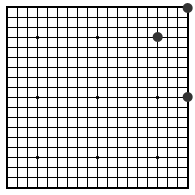 IntersectionThe players place stones alternately,with the first move made by the player with black stones. A stone once placed cannot be moved. Diagram I shows the grid pattern on the surface of the'Go'board. It consists of 19 vertical and horizontal lines. Stones may be placed only at the intersections of these vertical and horizontal lines.
Dia.2
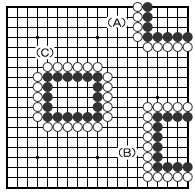 TerritoryTerritory is called'ji'in Japanese. Diagram 2 shows some examples. The continuous lines formed by the black stones form the limits of the territories. The size of territory is expressed in terms of the number of open intersections within it. The unit is called a point,'moku'in Japanese. The territories marked A, B and C are all of the same size..12 points for the black player. Incidentally, it is obvious here that to form territory, it is most efficient to make use of the edge lines as in the case of Pattern A. Pattern B, which makes use of one edge line is not as economical as A, but more economical than C, which must be entirely bounded by lines of stones.
Dia.3
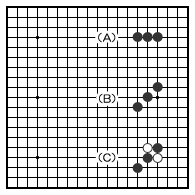 Contiguity of StonesThe unit for the number of stones is also called 'moku' the same as in the case of territory. All stones are of equal power, but like soldiers in a battle, the stones in a good configuration are more powerful than those in a poor pattern, in which the stones cannot function as effectively and economically.Stones of the same color form a firm line when they are placed contiguously along a straight line as in (A) in Diagram 3. These three black stones cannot be cut off. When they are diagonally contiguous as in (B), however, they are not directly connected with one another. Therefore, they can be cut off if the opponent places his stones as in (C). Remember an isolated stone means less power for the contestant who has such a stone.
Dia.4
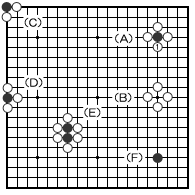 Life of a StoneA stone has life and it may be killed. This is crucial element that makes'Go'an interesting game.In Diagram 4, Pattern A shows a black stone being surrounded by three white stones. When the fourth white stone is placed at (1), the black stone is killed and is immediately removed from the board by the white player. Pattern B shows the result of the removal of the black stone. Pattern C, D and E all show black stones that are dead because they are surrounded by the stones of the adversary.
Dia.5
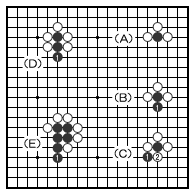 In Patterns A of Diagram 5, the black stone would be killed if the white player places the fourth stone at (a). This situation is called'atari. 'The player whose stone is in an'atari'can'run.' This may be done by placing another black stone next to the one on the board as in Pattern B. But if the second black stone is placed diagonally as in Pattern C, it is meaningless, because the white player, by placing the fourth white stone at (2) can still kill the first black stone. The black stone to be placed at (1) in Patterns D and E shows the black player's attempt at running away from capture. Pattern F in Dia.4 shows a stone with four liberties (breathing spaces).
|
| [ top pagebpage next ] |